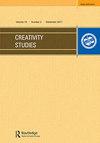THE ROLE OF CREATIVITY IN INTERPERSONAL COMMUNICATION IN DANCE AND MOVEMENT THERAPY: NARRATIVES OF PRACTITIONERS
Q1 Social Sciences
引用次数: 0
Abstract
Based on the qualitative data, this paper aims to disclose the role of creativity in the therapeutic process from the perspective of dance and movement therapists in Lithuania. The literature on the concept of creativity and its interlinks with communication and the role of creativity is discussed. Based on the semi-structured interviews with dance and movement therapy practitioners, empirical findings reveal the role and meaning of creativity in the therapeutic process and discuss the elements of creativity in dance and movement therapy: game, spontaneity, and imagination. The practitioners of dance and movement therapy tend to conceptualize creativity broader than the classical definitions suggest. The role of creativity subjectively is interpreted as fundamental in the therapeutic process. It binds all other elements of the therapeutic process (such as movement, dance, and a therapeutic relationship); it is seen as a part of the communicative process between the therapist and a client. More specific identifications of the role of creativity foresee creativity as allowing to make a distance from emotionally painful situations and emotions.创造性在舞蹈和动作治疗中人际交往中的作用:实践者的叙述
基于定性数据,本文旨在从立陶宛舞蹈和运动治疗师的角度揭示创造力在治疗过程中的作用。讨论了关于创造力的概念及其与交流的联系以及创造力的作用的文献。基于对舞蹈和运动疗法从业者的半结构化访谈,实证结果揭示了创造力在治疗过程中的作用和意义,并讨论了创造力在舞蹈和运动治疗中的要素:游戏、自发性和想象力。舞蹈和运动疗法的从业者倾向于将创造力概念化,其范围比经典定义所暗示的要广。创造性的作用在主观上被解释为治疗过程中的基础。它结合了治疗过程中的所有其他元素(如运动、舞蹈和治疗关系);它被视为治疗师和客户之间交流过程的一部分。对创造力作用的更具体的识别将创造力视为与情感痛苦的情况和情绪保持距离。
本文章由计算机程序翻译,如有差异,请以英文原文为准。
求助全文
约1分钟内获得全文
求助全文
来源期刊

Creativity Studies
Social Sciences-Cultural Studies
CiteScore
3.20
自引率
0.00%
发文量
38
审稿时长
15 weeks
期刊介绍:
Creativity Studies accepts original research articles with a focus on communication within the creative society. The journal welcomes contributions from scholars from diverse disciplines such as philosophy, sociology, history, political, communication and information sciences. Creativity Studies also publishes survey papers and descriptions of academic events in this area. The journal issues will be organized around different issues on creativity.
 求助内容:
求助内容: 应助结果提醒方式:
应助结果提醒方式:


